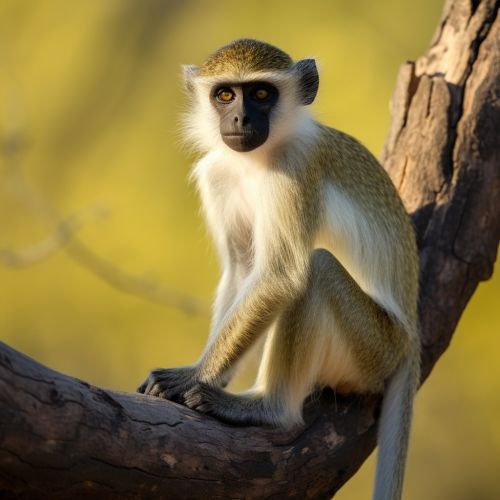Vervet monkey
Taxonomy and Evolution
The Vervet monkey, or Chlorocebus pygerythrus, is a primate species belonging to the family Cercopithecidae. This family is known for its Old World monkeys, which are native to Africa and Asia. The genus Chlorocebus to which the Vervet monkey belongs, consists of six species, all commonly referred to as green monkeys due to their greenish-yellow fur.
The Vervet monkey is thought to have evolved from the same ancestors as the other members of its genus around 3 million years ago. The exact evolutionary path is still a subject of ongoing research, with scientists using molecular phylogenetics to trace the lineage of these primates.


Physical Characteristics
Vervet monkeys are medium-sized primates, with males being larger than females. Adult males weigh between 3.9 to 8 kg, while females weigh between 2.3 to 5.3 kg. They have a body length of 42 to 60 cm, not including the tail, which can be as long as 50 cm.
Their fur is predominantly greenish-yellow, with a white underbelly. The face, ears, hands, feet, and the tip of the tail are black. They have a distinctive white fringe of hair, which runs from the eyebrows to the ears, framing their black face.
One of the most notable physical characteristics of Vervet monkeys is their blue scrotum, which contrasts sharply with their red penis. This is believed to be a form of sexual selection, with the bright colors serving to attract females or intimidate rival males.
Behavior and Ecology
Vervet monkeys are diurnal, meaning they are active during the day and sleep at night. They are highly social animals, living in groups of 10 to 50 individuals. These groups, or troops, are organized in a strict hierarchical system, with dominant males and females leading the group.
Vervet monkeys are omnivorous, feeding on a diet that includes fruits, flowers, leaves, seeds, and insects. They have also been known to eat small vertebrates. Their feeding behavior is flexible and adaptable, allowing them to survive in a variety of habitats.
These monkeys are known for their complex communication system, which includes a range of vocalizations, facial expressions, and body postures. They have specific alarm calls for different types of predators, such as eagles, snakes, and leopards.
Vervet monkeys have a unique behavior known as 'aunting', where females other than the mother help in caring for the young. This behavior is thought to strengthen social bonds within the troop and increase the survival chances of the young.
Distribution and Habitat
Vervet monkeys are found throughout sub-Saharan Africa, from Senegal and Ethiopia in the north to South Africa in the south. They inhabit a wide range of habitats, including savannas, woodlands, riverine forests, and mountainous regions. They have also adapted to live in urban areas, often coming into conflict with humans as a result.
Conservation Status
The Vervet monkey is listed as 'Least Concern' on the IUCN Red List. However, they face threats from habitat loss due to deforestation and agriculture, as well as hunting and trapping for the pet trade. Conservation efforts are focused on protecting their habitats and regulating hunting and trade.
